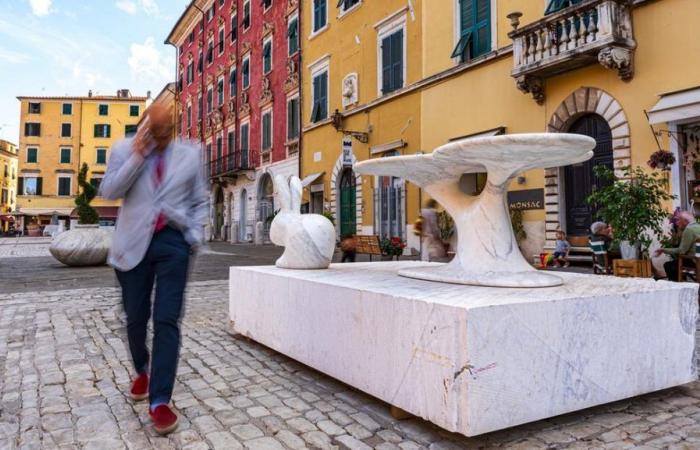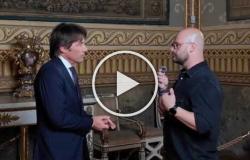In the name of absolute white, with some concessions to the over thirty varieties in which marble is available in its city of origin. This is the dominant one that runs along the streets of White Carraramanifestation that from June to September 29th celebrates Made in Italy design and the excellence of the territory through a widespread exhibition of iconic pieces, to tell a story of creativity and high craftsmanship handed down over time.
Protagonist of the eighth edition – entitled “Design is back” and directed by Domenico Raimondi – is the white Carrara marblewhich over the centuries has attracted artists from all over the world, supported by qualified workers and advanced technology.
“The public will see the fruit of meticulous work carried out in synergy with the companies, to bring the works back to the city from which they originated,” explains Raimondi. Often, in fact, Carrara does not enjoy the creation of the artefact, which takes off for other shores”. Promoted and produced by the Municipality of Carrara in collaboration with Internazionale Marmi, Macchine CarraraFiere and Nausicaa, in partnership with the North-West Tuscany Chamber of Commerce, the cultural event puts the city on a pedestal, en plein airas the culmination of some projects that have become famous and created in its laboratories, and how incubator of ideas and proposals that bring together designers, architects and artists, artisans and companies, as well as many enthusiasts.
The initiative has led renowned Italian design brands such as Alessi, Antonio Lupi Design, Bosa and Martinelli Luce to forge new collaborations with local companies, at the invitation of Domenico Raimondi. “Design is back” therefore becomes an opportunity for pay homage to key pieces, but also to present new out-of-scale marble productions. Let’s discover them together.
On show
There sculpture Anna G. it is made in a unique example with veined statuary marble by Sa.Ge.Van., for the twentieth anniversary of the corkscrew of the same name, designed by Alessandro Mendini for Alessi in 1994.
‘Anna G.’, by Alessandro Mendini for Alessi (photo Giuseppe D’Aleo)
Designed by Stefano Giovannoni and created by Robot City in 2014 for the Salone del Mobile, Tree Table + Rabbit Chair it is a marble installation composed of a phytomorphic table and zoomorphic seats in the shape of rabbits. Over time, Tree Table + Rabbit Chair have transformed into a family of Qeeboo products with a strong media impact.
Soul it is a pouf-sculpture in statuarietto marble with original fluid lines. Conceived by architect Simone Micheli in 2023, it enhances the essence of the millenary material through soft and unexpected shapes. Thanks to the synergy between Alessi, Franchi Umberto Marmi and Angeloni Marble studio, the Plissè collection, designed by Michele De Lucchi. A large marble kettle, sculptural yet very light, capable of restoring the dynamism of the pleated dresses of the fifties and sixties.
Elena Salmistraro and the Barattini family, through Studi d’Arte Carrara, have instead created Bernardo in the precious white marble of the Michelangelo Caves. Bernardo is a panda, designed in 2020 and produced by Bosa Ceramiche, symbol of all species at risk of extinction and ready to fight to defend animals, reminding us how vital the salvation of our planet is.
Paolo Ulian, trained at the local Academy of Fine Arts, exhibits the Gomitolo tableproduced by Bufalini Marmi through the concentric processing of a single slab “which allows us to reduce waste of material to a minimum”, recalls director Raimondi, and in addition Introvert and Pixeltwo cylindrical washbasins for Antonio Lupi Design, which through human intervention reveal unique and unrepeatable shapes.
Foto Design is back
In the context of “Design is back” visitors will also be able to see smaller objects, displayed in shop windows and in vacant rooms. Among these, the eight lamps/sculptures from the ‘Luci di Cava’ projectcreated by 8 internationally prestigious designers, with the technical assistance of Martinelli Luce and the support of FIDI – Florence Institute of Design International, the ‘Up&Up’ and ‘La Casa di Pietra’ collections by Gumdesign.
“Devolving into interior design, the ‘White 2024’, of which Cinzia Compalati’s Culture Office directed all the executive phases, has brought Carrara back to the center of a tradition that the local stone companies have never abandoned, that of research, design and development of white marble objects, protagonists of important showcases, now outside the walls – said Gea Dazzi, councilor for Culture and Education -. It is a homecoming of beauty and innovation around marble”.
“Over the years – explains Domenico Raimondi – Italian and international design has resorted to the Carrara quarries for the creation of everyday objects with a high aesthetic value, which often remain hidden, locked up in laboratories and with tight processing times, only to then reveal themselves in stores and showrooms all over the world.” The students of the Academy of Fine Arts have also joined this renewed creative hotbed, which in the recent past saw Santini, Munari, Coppola and Mangiarotti as teachers. The students created some inspired product design projects using marble.
Two exhibitions at MudaC
To complete a rich thematic offering, two exhibitions hosted at the MudaC headquarters edited by Cinzia Compalati. They open to the public “Directions” by Paolo Cavinato And “To the mountains” by Gabriele Landi. Cavinato uses a unique visual language that combines painting, sculpture, photography, architecture, scenography and music to explore space and time, inside and outside, stimulating us to become aware of antithetical themes such as body and mind, nature and artifice . His installations arouse wonder and anxiety, encouraging us to confront complexity. Landi proposes a new installation and site specific for mudaC, which is inspired by the ‘Captain’s Testament’, a dramatic song of the Alpine troops. On one side, a full-wall, skin-wide cartographic map of a vibrant color that recalls the glow of marble under the sun. Of an opposite nature is an installation that represents the reflection of those mountains, the valley, which brings with it anthropic signs and human presences.






